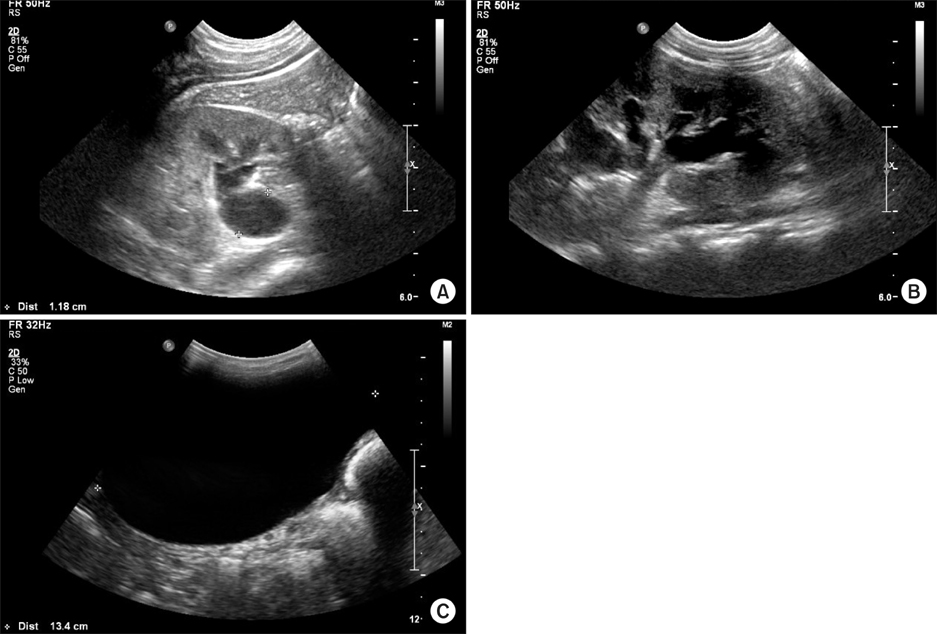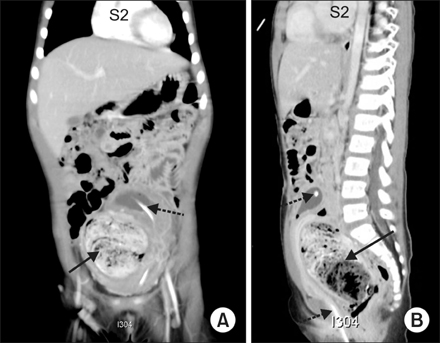Pediatr Gastroenterol Hepatol Nutr.
2013 Sep;16(3):200-205. 10.5223/pghn.2013.16.3.200.
Acute Urinary Retention in a 47-month-old Girl Caused by the Giant Fecaloma
- Affiliations
-
- 1Department of Pediatrics, Gyeongsang Institute of Health Sciences, Gyeongsang National University School of Medicine, Jinju, Korea. seozee@gnu.ac.kr
- 2Department of General Surgery, Gyeongsang Institute of Health Sciences, Gyeongsang National University School of Medicine, Jinju, Korea.
- 3Department of Urology, Gyeongsang Institute of Health Sciences, Gyeongsang National University School of Medicine, Jinju, Korea.
- KMID: 2051335
- DOI: http://doi.org/10.5223/pghn.2013.16.3.200
Abstract
- We present a case of a 47-month-old female suffering from acute urinary bladder neck obstruction and bilateral hydronephrosis secondary to a fecaloma. Fecaloma is defined as an accumulation of inspissated feces in the colon or rectum giving the appearance of an abdominal mass. A fecaloma can be developed by diverse causes and the causes of the fecaloma in this case were septum reformation after the Duhamel procedure and long-term constipation. Chronic constipation is very common at outpatient clinic. However, acute urinary retention and voiding difficulty caused by fecaloma in the giant Duhamel pouch has never been reported in Korea. We would like to present our case with acute urinary retention due to a fecaloma and suggest that fecaloma might be considered as one of the causes for acute urinary retention, especially in cases with previous Duhamel operation for repair of Hischsprung disease.
Keyword
MeSH Terms
Figure
Cited by 1 articles
-
Ileal Fecaloma Presenting with Small Bowel Obstruction
Ha Yeong Yoo, Hye Won Park, Seong-Hwan Chang, Sun Hwan Bae
Pediatr Gastroenterol Hepatol Nutr. 2015;18(3):193-196. doi: 10.5223/pghn.2015.18.3.193.
Reference
-
1. Gatti JM, Perez-Brayfield M, Kirsch AJ, Smith EA, Massad HC, Broecker BH. Acute urinary retention in children. J Urol. 2001; 165:918–921.
Article2. Kerrigan DD, Lucas MG, Sun WM, Donnelly TC, Read NW. Idiopathic constipation associated with impaired urethrovesical and sacral reflex function. Br J Surg. 1989; 76:748–751.
Article3. Garisto JD, Campillo L, Edwards E, Harbour M, Ermocilla R. Giant fecaloma in a 12-year-old-boy: a case report. Cases J. 2009; 2:127.
Article4. Chatoorgoon K, Pena A, Lawal TA, Levitt M. The problematic Duhamel pouch in Hirschsprung's disease: manifestations and treatment. Eur J Pediatr Surg. 2011; 21:366–369.
Article5. Nurko S. Management of surgical patients. In : Walker WA, Goulet O, Kleinman RE, Sherman PM, Shneider B, Sanderson IR, editors. Pathophysiology, diagnosis, management. 4th ed. Ontario: BC Decker Inc.;2004. p. 2119–2126.6. Weber TR, Fortuna RS, Silen ML, Dillon PA. Reoperation for Hirschsprung's disease. J Pediatr Surg. 1999; 34:153–157.
Article7. Langer JC. Repeat pull-through surgery for complicated Hirschsprung's disease: indications, techniques, and results. J Pediatr Surg. 1999; 34:1136–1141.
Article8. Wang KR, Huang FY, Chang PY, Chen CC. Congenital megacolon presented as fecaloma and urinary tract infection. Report of one case. Zhonghua Min Guo Xiao Er Ke Yi Xue Hui Za Zhi. 1989; 30:437–441.9. Araki T, Miki C, Yoshiyama S, Toiyama Y, Sakamoto N, Kusunoki M. Total proctocolectomy and ileal J-pouch anal anastomosis for chagasic megacolon with fecaloma: report of a case. Surg Today. 2006; 36:277–279.
Article10. Ribas Y, Bargalló J, Lamas S, Aguilar F. Idiopathic sigmoid megacolon with fecal impaction and giant calcified fecaloma. Am Surg. 2013; 79:E96–E97.
Article11. Yucel AF, Akdogan RA, Gucer H. A giant abdominal mass: fecaloma. Clin Gastroenterol Hepatol. 2012; 10:e9–e10.
Article12. Boemers TM, Bax NM, Van GJ. The effect of rectosigmoidectomy and Duhamel-type pull-through procedure on lower urinary tract function in children with Hirschsprung's disease. J Pediatr Surg. 2001; 36:453–456.
Article13. Loening-baucke V. Constipation in early childhood: patient characteristics, treatment, and longterm follow up. Gut. 1993; 34:1400–1404.
Article14. Veiga ML, Lordêlo P, Farias T, Barroso C, Bonfim J, Barroso U Jr. Constipation in children with isolated overactive bladder. J Pediatr Urol. 2013; [Epub ahead of print].15. Oestmann A. Hydronephrosis in impacted feces. Schweiz Med Wochenschr. 1997; 127:1925.16. Delaere KP, Braam PF, Debruyne FM. Unilateral hydroureteronephrosis resolved by fecal disimpaction in a patient with neurogenic bladder. Acta Urol Belg. 1983; 51:289–292.17. Knobel B, Rosman P, Gewurtz G. Bilateral hydronephrosis due to fecaloma in an elderly woman. J Clin Gastroenterol. 2000; 30:311–313.
Article18. Yuan R, Zhao GG, Papez S, Cleary JP, Heliotis A. Urethral obstruction and bilateral ureteral hydronephroses secondary to fecal impaction. J Clin Gastroenterol. 2000; 30:314–316.
Article19. Paquette EL, Peppas DS. Lower pole ureteral obstruction secondary to fecal impaction in an 8-year-old girl. Tech Urol. 2001; 7:299–301.20. Kantarci M, Fil F. Education and imaging. Gastrointestinal: fecaloma in a dilated sigmoid colon. J Gastroenterol Hepatol. 2007; 22:955.
Article
- Full Text Links
- Actions
-
Cited
- CITED
-
- Close
- Share
- Similar articles
-
- Acute Hydronephrosis owing to A Giant Fecaloma in an Older Patient
- A Case of Imperforated Hymen Associated with Acute Urinary Retention
- A Case of Imperforate Hymen with Acute Urinary Retention
- A Case of Acute Urinary Retention Caused by Hematocolpos Secondary to Imperforate Hymen
- Acute Urinary Retention due to Aseptic Meningitis: Meningitis-Retention Syndrome





